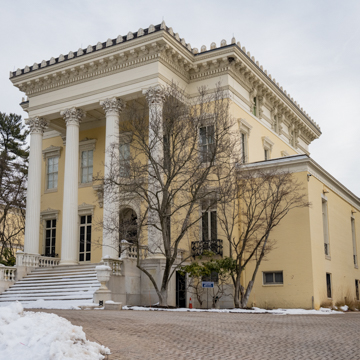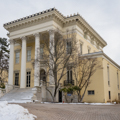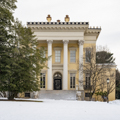Primarily associated with the Garrett family of B&O Railroad fame and wealth, Evergreen House was renovated and expanded multiple times by Baltimore’s finest architects. The original construction of an Italianate villa for William Broadbent in 1857–1858 is attributed to builder Hogg. The house changed hands several times until it was purchased by T. Harrison Garrett and his wife Alice Whitridge Garrett in 1878. The Garretts’ major renovation and expansion campaign in the mid-1880s was overseen by Carson, including nearly doubling the size of the house with the porte-cochere wing and gymnasium.
When the next generation of the Garrett family inherited the property in 1920, Evergreen was an impressive ensemble of a house with forty-eight rooms and fifty acres of gardens. Diplomat John Work Garrett and his wife Alice Warder Garrett sought to update the entire house according to modern taste and sensibilities. Architect Fowler spent a large portion of his career helping the Garretts modify the fussy eclecticism of earlier generations into an elegant early-twentieth-century country house.
Starting with converting the second story of the north wing into a theater and redoing a billiard room and bowling alley into museum space, Fowler’s changes also accommodated the artistic interests of the younger Garretts. The couple were accomplished collectors—the new space would house John Garrett’s Chinese porcelain and Japanese netsuke (small carved ornaments worn as part of traditional Japanese dress)—and Alice Garrett both performed and hosted visiting artists in her theater. Fowler also worked with her to transform the gardens with the addition of a piazza and formal Italian-style plantings and features. Other noteworthy changes included the theater interior by Russian émigré theater stage and costume designer Léon Baskt. Baskt’s work here is characterized by bold colors and geometric forms inspired by Russian folk art. Miguel Covarrubius, the Mexican artist and illustrator, was commissioned to paint scenes of John Work Garrett’s diplomatic career in the New Library designed by Fowler in 1932. The house has been jointly managed by The Johns Hopkins University and the Evergreen House Foundation since 1952 and is open for regular house museum tours and events.


















